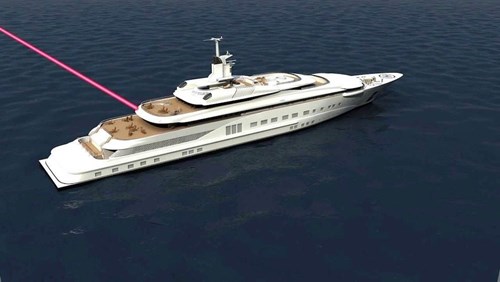Thinking of Going Flat?

If you've visited a maritime trade show in the last year or so, you may have noticed something unusual among the familiar crop of white, mushroom-topped satellite antennas on some of the tech stands.
You might have spotted a strange, new, minimal form. In fact you may not have seen the low profile shape at all had it not been surrounded by excited sales people, be-dazzled customers and unsettling pictures of dome-free boats. But what are these amazing devices and how will they improve our lives?
By now, many in the marine industry have a good idea of how a conventional marine VSAT antenna works. These things are everywhere, providing internet, telephone and corporate data to vessels around the world. Stick your head through the door of any VSAT dome and you will immediately notice what is essentially, a standard satellite dish. On a ship though, motors, belts, wheels and sensors are added to keep the dish pointing peacefully at the satellite as chaos ensues below. And then there is the dome itself whose job is to keep the weather and seagulls out. That's pretty much it.

The new device however is flat. It is a solid-state VSAT in an elegant, wafer-thin package. All the moving parts are gone, so nothing to balance, break or burn-out. And importantly, for super yachts at least, so are the "ugly" VSAT domes. So far, so good. But before the second engineer gets the oxycutting gear out and ditches the domes over the side, there are couple of things to consider. First though, a bit about how these trans-formative devices work.
A flat panel VSAT is actually made of hundreds of micro-antennas arranged in a grid. Each micro-antenna transmits and receives the same signal. But small time delays are used to steer the beam towards the satellite. This isn't difficult to understand if you think about your ears. If you hear a loud noise off to one side, your instinct is to turn towards it. Even though you haven't seen what made the noise, you know which way to turn. The brain actually detects a tiny time difference between the sound in your left and right ears. It uses this to point you in the right direction.
A flat panel VSAT works in a very similar way. It measures the movement of the boat, then by adjusting time delays on each micro-antenna, "steers" the beam towards the satellite. If a conventional VSAT is like one big ear, then a flat panel is like hundreds of small ones, all working together.
However, there are gaps between all the "ears" where nothing can be heard. This brings us to the first limitation of a flat VSAT. It collects less energy for a given area than a conventional VSAT. It is less efficient.
The next problem is direction. When any satellite antenna is angled so it points perfectly at the satellite, it is collecting the maximum amount of signal. A conventional VSAT's motors always point it at the satellite.
However, a flat panel VSAT doesn't move, so it is almost always at some kind of angle to the satellite. The electronics point the beam to compensate, but the panel itself is still skewed. Some of the signal that would be collected if they could, is lost as it spills past the sides. Again, there is a performance hit from using a flat panel VSAT if the satellite isn't directly overhead. Communication satellites are very, very rarely directly overhead.
What this means is that the only practical way to get the same performance from a flat panel VSAT as a conventional VSAT is to have a very big one. Or to have several of them arranged to "see" in all directions. You would need at least five to cover the whole sky and probably more. Or of course, you could mount your flat panel and use motors to point it. Hang on, this is starting to look a bit like a conventional VSAT.
There are other problems too. Like where to put the powerful amplifiers needed to send satellite signals 35,000 Km through space. Right now, they fit nicely in the dome.
Flat panel is undoubtedly a fantastic technology and is widely used in military radar for example. It will eventually change things in the civilian world too. Especially when low and medium earth orbit satellite networks such as One Web come online. Here for example, flat panels have the potential to talk to many satellites simultaneously as they whizz overhead. This will be a real benefit.

And at the very top of the yacht market, there are a few owners who don't care about the risk and expense of installing multiple, early model (let's face it prototype) antennas and heaps of supporting equipment and bulky RF cables. It doesn't matter that flat panel will only work in a very few places if those are the places you happen to want to go.
For the vast majority of ship and boat operators in all maritime markets however, with the mature technology of global, conventional VSAT getting smaller, more reliable and more affordable by the day, my feeling is that it will be many years before flat panels become a viable proposition in most cases.